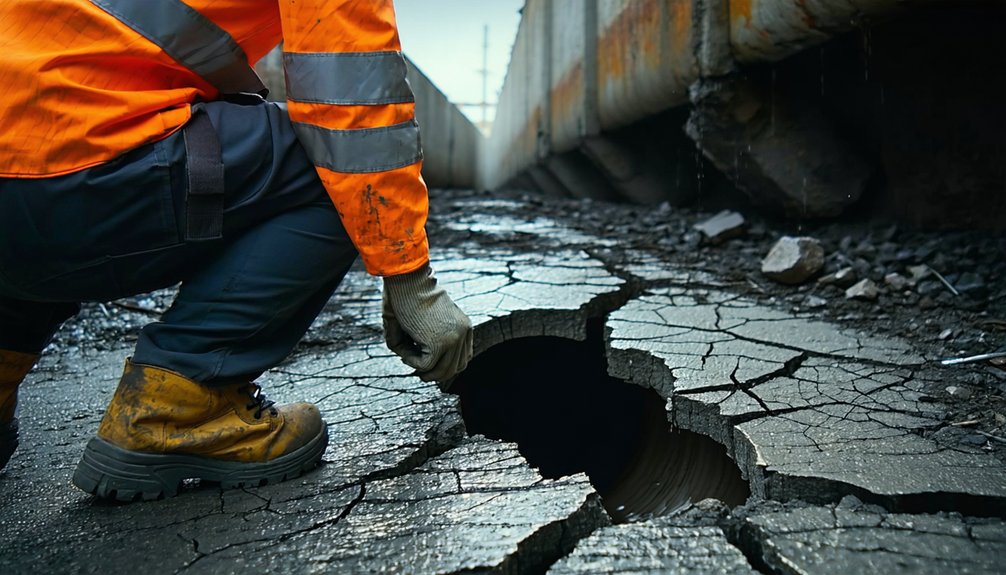Several key factors influence sewer line repair costs. The type of damage, whether minor or extensive, plays a vital role in determining expenses. Additionally, the location and accessibility of the damage affect labor and equipment requirements, especially in hard-to-reach areas. Finally, the chosen repair method, including traditional and trenchless techniques, impacts overall costs. By understanding these factors, one can better navigate the complexities of sewer line repairs and their associated costs moving forward.
Type of Damage
The type of damage to sewer lines directly influences repair costs and methods. Minor issues, such as small clogs or cracks, generally require less expensive repairs, averaging between $50 and $250 per foot. In contrast, extensive damage, including collapsed pipes or root intrusion, complicates the repair process and greatly elevates repair costs. Full sewer line replacements for major breaks can range from $3,000 to $7,000, reflecting the severe nature of such damage. Early detection plays an essential role in mitigating costs; addressing minor issues promptly can prevent them from escalating and necessitating specialized repair techniques. Regular maintenance and inspections serve as proactive measures that can identify vulnerabilities before they evolve into costly extensive damage, ultimately preserving financial resources for homeowners. Understanding the type of damage is important for evaluating repair strategies and making informed decisions about sewer line repairs.
Location of Damage
Location of damage greatly influences the overall cost and complexity of sewer line repairs. Damage situated in hard-to-reach areas, such as beneath buildings or driveways, often incurs higher repair costs due to accessibility challenges. These scenarios typically require more elaborate excavation techniques, which can escalate labor rates and equipment expenses. Additionally, landscaping obstacles may necessitate further excavation or tunneling, complicating repairs and extending timelines. The depth and length of the sewer line also play a critical role; deeper lines generally demand more intensive labor and heavier equipment, further increasing costs. These factors can limit repair method options, frequently leading to the necessity of traditional excavation, which is both invasive and costly.
| Type of Damage | Repair Costs | Accessibility Challenges |
|---|---|---|
| Beneath Buildings | High | Significant |
| Under Driveways | High | Significant |
| Landscaped Areas | Medium to High | Moderate to Significant |
| Shallow Lines | Low to Medium | Minimal |
| Deep Lines | High | Significant |
Repair Method
When evaluating sewer line repair methods, the specific nature of the damage greatly dictates the choice of approach. Traditional methods, primarily involving excavation, are often invasive and can incur costs ranging from $50 to $250 per foot, depending on the severity of the damage and site conditions. In contrast, trenchless repair techniques like pipe lining and pipe bursting offer less disruptive solutions, typically costing between $60 and $250 per foot while potentially minimizing restoration expenses post-repair. For minor issues, spot repairs can provide a targeted, cost-effective option without extensive excavation. The severity of the damage considerably influences the suitability of the repair method, as more severe cases may require specialized techniques that increase overall costs. Therefore, a thorough evaluation of the damage is essential to selecting the most effective repair method, impacting both the repair timeline and financial outlay associated with sewer line repair.
Frequently Asked Questions
Why Is Sewer Line Replacement so Expensive?
Sewer line replacement is remarkably expensive due to various factors. Replacement costs often encompass excavation fees, which can greatly increase total expenses, particularly when addressing tree roots or aging infrastructure. The choice of plumbing materials also plays a pivotal role, with modern options potentially costing more. Labor charges are influenced by local rates and the complexity of repair methods, while inspection services may be necessary for emergency repairs, further driving up overall costs.
What Costs Are Involved in a Sewer System?
Sewer system costs encompass various expenses, including sewer maintenance expenses, inspection fees, and labor costs, which vary by geographic location. Pipe materials greatly influence overall expenditures, while permitting charges and excavation costs may apply, particularly for emergency repairs. System age and property access also factor into the financial equation, as older systems often require more extensive interventions. Accurate budgeting necessitates a thorough understanding of these multifaceted cost components.
Are Local Governments Responsible for Paying for Sewer Line Repairs?
In the grand theater of public infrastructure, the question of sewer line repair funding emerges as a pivotal act. Local governments bear the mantle of responsibility, dictated by unique local policies. Maintenance budgets often dictate the flow of resources, while tax implications ripple through service areas. Cost-sharing agreements may foster community impact, but ultimately, homeowners frequently shoulder the burden, guiding through the intricate dance of obligations and support within their municipalities.
Does Homeowners Insurance Cover Sewer Lines?
Homeowner policies typically do not cover sewer damage unless caused by specific incidents, such as water backups from storms. Coverage limits and repair exclusions vary greatly across policy types. Homeowners must conduct preventive maintenance to mitigate potential issues, as many policies may exclude damages from neglected sewer lines. When filing insurance claims, it is essential for homeowners to assess costs accurately, ensuring they understand their coverage to avoid unexpected financial burdens.



